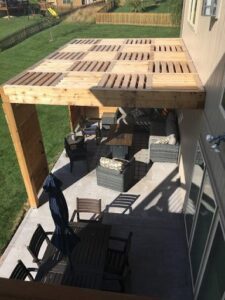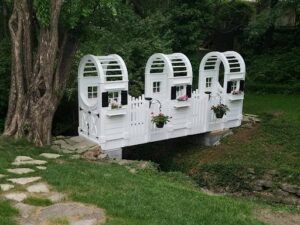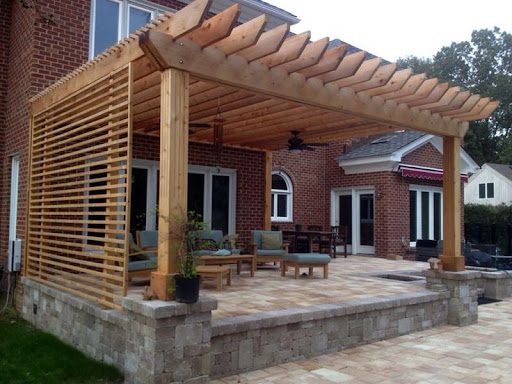There are a lot of garden structures with lots of fancy names. It’s easy to lump them all together. At Creative Concepts and Design, we build many of these structures. Here’s a little rundown of some of the most popular garden structures and the differences between them.
How is a Pergola Different From a Gazebo?

A pergola is a structure that provides partial shelter and shade over a garden, pathway, or patio. The main difference between a pergola and a gazebo is the function of the roof. A pergola allows for sunlight to shine through its slatted roof. A gazebo has a solid roof. We believe pergolas are often the most misunderstood and underappreciated additions when it comes to design.
Reasons to Build a Custom Pergola

- Pergolas create an environment or defined space to stage.
- Pergolas offer shade from the sun.
 Pergolas offer something an enclosure cannot.
Pergolas offer something an enclosure cannot.- Pergolas can be upgraded to have lighting, ceiling fans, chandeliers, roofs,
speakers, swoosh shades, fireplaces, outdoor bar/grill, curtains, and blinds. - Pergolas offer a more organic ambient vibe than an enclosure.
- Pergolas are a fraction (⅓-½) of the cost of an enclosure.
- Pergolas soften a hardscape and create a warm enchanting craftsmanship feeling.
- The best material to build a pergola in the midwest is western red cedar due to its decay resistance and bug resistance. Cedar is also less prone to shrinking and twisting than treated lumber. If you plan to paint cedar, make sure and talk with the local paint rep and select a paint that is compatible with its high acidic tannins.
What Is a Gazebo?
 A gazebo is one of the oldest garden structures in existence. They feature a covered roof, open sides, and typically offer seating as well. The shape of a gazebo is what makes it unique. It is an octagonal or hexagonal shape creating a cozy gathering spot. They provide full coverage from the sun and larger structures can serve as the centerpiece of a large backyard. While usually freestanding buildings, they can be incorporated into decks as well. Gazebos are often seen in public parks and gardens. While strong on charm, from a practical standpoint, the octagon shape is hard to stage and a pavilion may offer more practical, usable space for residential applications. Contact us today to get started on one!
A gazebo is one of the oldest garden structures in existence. They feature a covered roof, open sides, and typically offer seating as well. The shape of a gazebo is what makes it unique. It is an octagonal or hexagonal shape creating a cozy gathering spot. They provide full coverage from the sun and larger structures can serve as the centerpiece of a large backyard. While usually freestanding buildings, they can be incorporated into decks as well. Gazebos are often seen in public parks and gardens. While strong on charm, from a practical standpoint, the octagon shape is hard to stage and a pavilion may offer more practical, usable space for residential applications. Contact us today to get started on one!
What Is a Pavilion?
 Unlike a gazebo, a pavilion is a roofed structure with completely open sides and no built-in floor. The roof is usually supported by 4-6 posts or more. They can be attached to a deck, paver patio, or concrete base. While many gazebos are octagonal or oval, most pavilions are rectangular. Additionally, a gazebo is more of a self-contained structure, while pavilions provide a roof for a patio or seating area below. The difference between a pavilion and a pergola is the roof. Both structures have open sides, but pergolas have open roofs that only partially block the sun and rain.
Unlike a gazebo, a pavilion is a roofed structure with completely open sides and no built-in floor. The roof is usually supported by 4-6 posts or more. They can be attached to a deck, paver patio, or concrete base. While many gazebos are octagonal or oval, most pavilions are rectangular. Additionally, a gazebo is more of a self-contained structure, while pavilions provide a roof for a patio or seating area below. The difference between a pavilion and a pergola is the roof. Both structures have open sides, but pergolas have open roofs that only partially block the sun and rain.
What Is a Lanai?
 Basically, any porch, veranda, or patio could be defined as a lanai, but it usually refers to a more expansive space, like an additional room outside a house. Lanais are connected to an entrance and covered by the building’s roof. They are found more often around the back of a building as opposed to a front entrance. Lanai’s are very popular in coastal regions where temperatures are consistent. In fact, the name originated in Hawaii. While beautiful, you will be hard-pressed to find a lanai that you will be happy with in a four-season environment such as Kansas City, mostly because of their poor insulating properties. They will be difficult to heat in the winter and have a greenhouse effect in the summer.
Basically, any porch, veranda, or patio could be defined as a lanai, but it usually refers to a more expansive space, like an additional room outside a house. Lanais are connected to an entrance and covered by the building’s roof. They are found more often around the back of a building as opposed to a front entrance. Lanai’s are very popular in coastal regions where temperatures are consistent. In fact, the name originated in Hawaii. While beautiful, you will be hard-pressed to find a lanai that you will be happy with in a four-season environment such as Kansas City, mostly because of their poor insulating properties. They will be difficult to heat in the winter and have a greenhouse effect in the summer.
What Is a Veranda?
 A veranda (or verandah) is a roofed, open-air porch attached to the outside of a building. It can stretch along one whole side of a building or even go around the corner and stretch along another side. Another name for this type of structure is a wraparound porch. Like other porches, it’s located on the floor level and placed under the roof of the main structure. It can be screened to create an extension of the living space and is often partly enclosed by a railing.
A veranda (or verandah) is a roofed, open-air porch attached to the outside of a building. It can stretch along one whole side of a building or even go around the corner and stretch along another side. Another name for this type of structure is a wraparound porch. Like other porches, it’s located on the floor level and placed under the roof of the main structure. It can be screened to create an extension of the living space and is often partly enclosed by a railing.
What Is a Trellis?



A trellis is the simplest example of garden architecture. It is a flat, two-dimensional structure that can be placed against a wall or can act as a wall. It can be solid but is often made of lattice or some other partially open material allowing it to serve as a privacy screen, or to dress up a large expanse of wall that could use some interest and color. Trellises can be made in various heights and widths from many different materials from wood to metal to PVC. They can support string lights and other decorative items to create ambiance as well. Trellises are perfect for climbing plants in the summer and are decorative in winter.
What Is an Arbor?
An arbor is more of a garden structure than a building. Arbors are basically two trellises connected by a top that can be straight or curved. They form an open structure with no front or back (with the exception of arbors with hinged gates attached to form an actual door). Many times, seats are incorporated into the structure either on the inside or outside depending on how wide it is. Arbors act like gates or doorways and look great at the beginning of a path or garden entryway. They beckon you to come through to see what’s on the other side. They are the perfect framework for climbing vines and add quite a bit of charm to a garden.



As part of the building, and yet separate areas, pergolas, verandas, lanais, and gazebos provide architectural beauty and create more usable living space in a home. We build all of these structures and we can help work them seamlessly into your deck or backyard project. Schedule your free, no obligation design meeting with us today, or give us a call!



